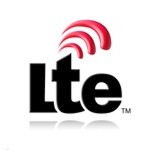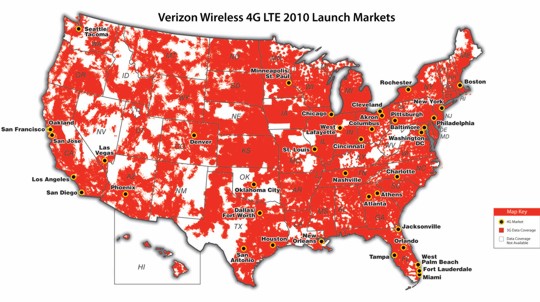 Lots of interesting news today for Verizon. They outlined their upcoming 4G LTE plans at the CTIA Enterprise & Applications™ 2010 conference in San Francisco. Their next generation wireless network, built on LTE technology, using 700 Mhz spectrum will launch in 38 markets and 60 airports by the end of calendar year 2010.
Lots of interesting news today for Verizon. They outlined their upcoming 4G LTE plans at the CTIA Enterprise & Applications™ 2010 conference in San Francisco. Their next generation wireless network, built on LTE technology, using 700 Mhz spectrum will launch in 38 markets and 60 airports by the end of calendar year 2010.
“We are driven by the vision to provide ubiquitous wireless broadband connectivity and mobility to rural and urban Americans alike. With our initial 4G LTE launch, we will immediately reach more than one-third of all Americans where they live, right from the start. And, we will quickly introduce 4G LTE throughout the Verizon coverage area,” said Lowell McAdam, president and chief operating officer of Verizon.
Verizon says the mobile broadband service will offer “…average data rates to be 5 to 12 megabits per second (Mbps) on the downlink and 2 to 5 Mbps on the uplink in real-world, loaded network environments.” Verizon highlighted the initial launch areas as the following (full list of markets and airports at the end of this post):
- Large sections of the Northeast Corridor, including Boston, New York, Philadelphia, Baltimore, and Washington, D.C. as well as Rochester, New York
- Throughout Miami and south Florida, Atlanta, Dallas-Fort Worth, Houston, and New Orleans as well as Charlotte, North Carolina and Nashville, Tennessee
- Chicagoland, St. Louis, the Twin Cities, Pittsburgh and major cities in Ohio
- Major population centers in California as well as Seattle, Phoenix, Denver and Las Vegas
We’ve also been covering Verizon’s program to partner with rural providers to expand LTE to rural markets. While details are somewhat lacking, Verizon has pushed the idea of leasing spectrum to rural carriers and allowing them to build out LTE to Verizon’s specifications, while also negotiating roaming agreements with these carriers. There’s some additional news on that as well. McAdam said at his press conference that agreements have been reached with five rural carriers, although he wouldn’t reveal who. Verizon also recently lobbied the FCC to encourage the use of USF funds to help their potential rural partners build out these rural markets. Current USF reform proposals, under the auspices of the national broadband plan, call for a mobility fund to assist in the build out of mobile broadband networks in rural markets.
On the device front, McAdam said Verizon will showcase half-a-dozen smartphones and tablets that will run on the new LTE network at the upcoming CES show in January, offering the first significant 4G competition to Sprint and Clearwire, who use rival WiMAX technology for their 4G efforts. The device announcement, while lacking in details right now, is somewhat surprising. Verizon wasn’t expected to have multiple LTE capable smartphones until well into their LTE deployment.
In related news, the Wall Street Journal is reporting that the iPhone will finally make its way to Verizon in early 2011, although initial reports say it will only be a 3G CDMA version. The Verizon iPhone move will end AT&T’s exclusive hold on the iPhone, which they have successfully leveraged since 2007.
As I discussed earlier, this new dawn of 4G wireless will have far reaching implications on the broadband industry, wireline and wireless alike.
Verizon Wireless 4G LTE Initial Major Metropolitan Area Deployment
- Akron, Ohio
- Athens, Georgia
- Atlanta, Georgia
- Baltimore, Maryland
- Boston, Massachusetts
- Charlotte, North Carolina
- Chicago, Illinois
- Cincinnati, Ohio
- Cleveland, Ohio
- Columbus, Ohio
- Dallas-Fort Worth Metroplex, Dallas, Texas
- Denver, Colorado
- Fort Lauderdale, Florida
- Houston, Texas
- Jacksonville, Florida
- Las Vegas, Nevada
- Los Angeles, California
- Miami, Florida
- Minneapolis/Saint Paul, Minnesota
- Nashville, Tennessee
- New Orleans, Louisiana
- New York, New York
- Oakland, California
- Oklahoma City, Oklahoma
- Orlando, Florida
- Philadelphia, Pennsylvania
- Phoenix, Arizona
- Pittsburgh, Pennsylvania
- Rochester, New York
- San Antonio, Texas
- San Diego, California
- San Francisco, California
- San Jose, California
- Seattle/Tacoma, Washington
- St. Louis, Missouri
- Tampa, Florida
- Washington, D.C.
- West Lafayette, Indiana
- West Palm Beach, Florida
Verizon Wireless 4G LTE Initial Commercial Airport Deployment (Airport Name, City, State)
- Austin-Bergstrom International, Austin, Texas
- Baltimore/Washington International Thurgood Marshal, Glen Burnie, Maryland
- Bob Hope, Burbank, California
- Boeing Field/King County International, Seattle, Washington
- Charlotte/Douglas International, Charlotte, North Carolina
- Chicago Midway International, Chicago, Illinois
- Chicago O’Hare International, Chicago, Illinois
- Cincinnati/Northern Kentucky International, Covington, Kentucky
- Cleveland-Hopkins International, Cleveland, Ohio
- Dallas Love Field, Dallas, Texas
- Dallas/Fort Worth International, Fort Worth, Texas
- Denver International, Denver, Colorado
- Fort Lauderdale/Hollywood International, Fort Lauderdale, Florida
- George Bush Intercontinental/Houston, Houston, Texas
- Greater Rochester International, Rochester, New York
- Hartsfield-Jackson Atlanta International, Atlanta, Georgia
- Honolulu International, Honolulu, Hawaii
- Jacksonville International, Jacksonville, Florida
- John F. Kennedy International, New York, New York
- John Wayne Airport-Orange County, Santa Ana, California
- Kansas City International, Kansas City, Missouri
- La Guardia, New York, New York
- Lambert-St. Louis International, St. Louis, Missouri
- Laurence G. Hanscom Field, Bedford, Massachusetts
- Long Beach/Daugherty Field, Long Beach, California
- Los Angeles International, Los Angeles, California
- Louis Armstrong New Orleans International, Metairie, Louisiana
- McCarran International, Las Vegas, Nevada
- Memphis International, Memphis, Tennessee
- Metropolitan Oakland International, Oakland, California
- Miami International, Miami, Florida
- Minneapolis-St. Paul International/Wold-Chamberlain, Minneapolis, Minnesota
- Nashville International, Nashville, Tennessee
- New Castle, Wilmington, North Carolina
- Newark Liberty International, Newark, New Jersey
- Norman Y. Mineta San Jose International, San Jose, California
- North Las Vegas, Las Vegas, Nevada
- Orlando International, Orlando, Florida
- Orlando Sanford International, Sanford, Florida
- Palm Beach International, West Palm Beach, Florida
- Philadelphia International, Philadelphia, Pennsylvania
- Phoenix Sky Harbor International, Phoenix, Arizona
- Phoenix-Mesa Gateway, Mesa, Arizona
- Pittsburgh International, Pittsburgh, Pennsylvania
- Port Columbus International, Columbus, Ohio
- Portland International, Portland, Oregon
- Rickenbacker International, Columbus, Ohio
- Ronald Reagan Washington National, Arlington, Virginia
- Sacramento International, Sacramento, California
- Salt Lake City International, Salt Lake City, Utah
- San Antonio International, San Antonio, Texas
- San Diego International, San Diego, California
- San Francisco International, San Francisco, California
- Seattle-Tacoma International, Seattle, Washington
- St. Augustine, Saint Augustine, Florida
- St. Petersburg-Clearwater International, Clearwater, Florida
- Tampa International, Tampa, Florida
- Teterboro, Teterboro, New Jersey
- Trenton Mercer, Trenton, New Jersey
- Washington Dulles International, Dulles International Airport, Washington, D.C.
- Will Rogers World, Oklahoma City, Oklahoma
- William P. Hobby, Houston, Texas



